Vintage Turkish rugs are a designer go-to for their bold color combinations and durability. Whether used as an accent rug or focal point, they can tie together a room’s decor and serve as a beautiful wall hanging.
With a variety of sizes available, there’s a Turkish rug to fit any space. From kilims that showcase traditional patterns to runners that add bold flair, read on to learn more about these stunning pieces.
Origins
The artisanry in antique Turkish rugs goes beyond a decorative accent. Each rug represents a piece of cultural heritage and history, reflecting centuries of artistic expression from one of the world’s oldest surviving cultures.
Vintage Turkish rugs have long been revered for their lustrous pastels and monumental botanical motifs. Their designs vary depending on the region and the ethnic background of the weavers. They are known for their superior weaving techniques and intricate patterns that showcase the cultural and art influences of the era.
The origins of Turkish rugs trace back to nomadic tribes that woven them into basic floor coverings. Their art and craft went on to become a symbol of wealth, status, religion, and culture. They were used as prayer rugs, wall tapestries, table cloths, and even dowry gifts. Some were so popular that they became a staple of Renaissance European paintings. The woven jewels that are now treasured by designers and collectors around the world are a result of this rich tradition and history.
Styles
As Turkish culture embraced and adopted new styles over the centuries, so did rug weaving. As a result, antique and vintage Turkish rugs often feel both ancient and modern at once. This is especially true of their color palettes, which have changed over time. While traditional rugs use the color red to signify wealth and prosperity for newlyweds, contemporary weavers tend to favor more monochromatic shades.
From rustic living rooms to palatial dining spaces, antique and vintage Turkish rugs offer a wide variety of styles to match any design style. From kilims that feature intricate geometric patterns to gabbeh rugs with abstract lines, there is a Turkish carpet to suit any home.
From resale boutiques to online Etsy shops, finding an affordable vintage Turkish rug is easy. Just search for “vintage Turkish rug” and sort the results by price to find the best deals. Then, simply add your favorite to your cart and enjoy the beauty of a hand-woven masterpiece.
Materials
Vintage Turkish rugs feature a plethora of natural dyes, which age gracefully and lend a deep color saturation that enhances the rug’s visual texture. Chemical dyes, which were invented later, offered an expanded color palette, but they cannot replicate the subtle gradations of hue that natural vegetable dyes produce.
Antique and vintage Turkish rugs can add an elegant, pulled together look to any room, whether it’s a low-key oushak or a boldly patterned kilim. Pair them with coordinating furniture, such as leather chairs and wood coffee tables, for a sophisticated look that exudes comfort.
Keep in mind that a Turkish rug is not just a decorative item—it’s also a cultural artifact steeped in history. Authentic antique Turkish rugs hold substantial historical value and are considered heirlooms that are passed down through families. As such, it’s important to research and consult with a reputable rug appraiser before making an investment.
Care
Vintage Turkish rugs need to be cleaned professionally at least once every six months to two years. If you notice that the rug is looking dull and dingy, it’s time for a professional cleaning. You can also check if it’s time for a cleaning by rubbing the surface of the rug against the palm of your hand. If you feel a coarse, grating sensation, it’s time for a professional rug cleaning.
The attractive colors in vintage Turkish rugs are achieved using natural dyes, which are derived from vegetables, roots, plants, flowers, animals, and minerals. Unlike synthetic dyes, natural dyes are through and through—they don’t fade or come off easily.
Antique Turkish rugs are also often overdyed to bring out the original patterns or highlight specific elements of their design. This practice is part of the cultural fabric in Turkey, where household items are fixed up rather than discarded or thrown away. This gives the rugs a slightly washed out aesthetic that pairs beautifully with wood furniture and classic conversation pieces.


